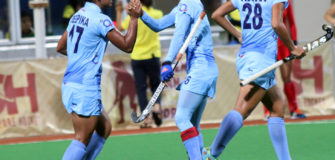Indian Express: Being a drag-flicker is like an artist drawing new lines says Rupinder
Indian Express: Being a drag-flicker is like an artist drawing new lines says Rupinder
Share
Indian Express: Being a drag-flicker is like an artist drawing new lines, says Rupinder Pal Singh
Rupinder emerged as the leading scorer with 11 goals in the Asian Champions Trophy at Kuantan, Malaysia.
By Nitin Sharma
Not many in Indian hockey circles know that drag-flicker Rupinder Pal Singh is a maternal cousin of former India player Gagan Ajit Singh, who would torment Pakistan defenders with his mazy runs and eye for goal in the early 2000s.
A meeting with Gagan’s teammate and drag-flicker Jugraj Singh in 2002 lured the Faridkot-born Rupinder into drag-flicking and the last five years have seen the 25-year-old defender taking on the drag-flicker’s role along with VR Raghunath and youngster Harmanpreet Singh. Rupinder emerged as the leading scorer with 11 goals in the Asian Champions Trophy at Kuantan, Malaysia, and also took over the captain’s armband in the final against Pakistan in the absence of the injured PR Sreejesh.
In a chat with The Indian Express, Rupinder, who now has 70 international goals in more than 150 matches, talked about his role as a defender, drag-flicking and variations, coach Roelant Oltmans’s plans for the team and the path post Rio Olympics. Excerpts:
It was a team full of young defenders and the team was without VR Raghunath and Manpreet Singh. How do you see the role of defenders in the title triumph?
One of the team’s goals was to improve on our world ranking of six. This was our first tournament after the Rio Olympics and the more matches we play, the defenders will learn and gain experience. One thing which favours us is that our off-filed communication and coordination is good, and that helps during matches. The focus was on man-to-man marking and executing interception plans well. And also have to learn from mistakes or errors. Like in the semi-final against Korea, the strategy for me and Pardeep Mor was to block the line and play inside out to block their forwards. But that did not happen in the first two quarters. We discussed this and after half time we executed it.
In the absence of Raghunath and Harmanpreet Singh, you were the leading drag-flicker in the team. You have played along with these two for more than three years. Have you made any particular changes before or during the last six months?
It’s good that we have players like Raghunath and Harmanpreet, which means more variations and combinations. We discuss and spend time analysing videos of other goalkeepers. I was spending some time on creating some new variations and it was about how to deceive the goalkeeper about my shot. Earlier, I would hit the shot in the first battery but I also improvised on hitting the shot in the centre battery. Sreejesh, too, has been discussing various combinations during training and the focus has also been on how to create confusion in opposition goalkeepers’ minds.
Most of the drag flickers come on as substitutes for penalty corners. You also play the defender’s role for the major part of the four quarters. How different are the two roles for you, mentally and physically?
When I started as a drag-flicker in 2006 on the insistence of my coach Ramesh Pathania, the only thought in my mind was that I am a defender first and drag-flicker later. And that has been my mindset till now. In 2011, when I scored three goals against Great Britain in the Sultan Azlan Shah Cup, I thought I can play this role better. As a junior, I had a chance to spent time with Jugraj Singh and we have discussions now also. He would tell me that as a defender, when I would see players and tactics, I would understand and execute the drag-flicks better. Ground te khelega tan hi goal marega (If you play on the ground, you will also score). And it also helps me in defending.
How has been the role of coach Roelant Oltmans with the team for the past one year and how has he changed the team?
One thing which Oltmans has helped the team in is mentality. His focus has been to make us mentally strong and he spends time with individual players too discussing strengths and weaknesses. Psychologically , the team was behind when he joined but he has made sure we believe in ourselves. After the draw against Canada in Rio, he emphasised that it is a process and the team’s advantage is that we have an average age of 24-25 years, much lower compared to other teams. Mistakes happen but the youngsters need to learn, and that will make us a consistent team.
How do you see your role and the team ahead of the 2018 World Cup and 2020 Olympics?
The coming years are important for the team as well as my role in the team. As a defender, I have to be consistent and also make improvisations as a drag-flicker. It is like an artist drawing new lines every time he thinks. Maintaining fitness will be very important to perform well in the next World Cup as well as the other tournaments before the 2020 Olympics (in Tokyo). The consistency will help us before the next Olympics and whatever plans coach Oltmans would have for us, we would be ready to execute those.


